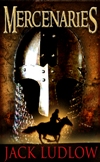The art of signing books
 Today, we were honoured with a visit from author Jack Ludlow. He came in to sign copies of his latest hardback release Mercenaries, the first in a new trilogy revolving around the Normans. I don’t think any other novelist has tackled this era before (correct me if I’m wrong!) which is odd as the Norman times is such a fascinating period of history. Or as Jack put it, “fascinating AND complex…and possibly the reason why no one has tackled this period before. Maybe they started and then gave up!”
Today, we were honoured with a visit from author Jack Ludlow. He came in to sign copies of his latest hardback release Mercenaries, the first in a new trilogy revolving around the Normans. I don’t think any other novelist has tackled this era before (correct me if I’m wrong!) which is odd as the Norman times is such a fascinating period of history. Or as Jack put it, “fascinating AND complex…and possibly the reason why no one has tackled this period before. Maybe they started and then gave up!”
Lucky for us, Jack didn’t give up and we can now get a captivating insight into this era. Click here to read a free extract, and if you want a chance to win one of the copies he signed today, just enter this month’s competition.
These books were signed with care, over a cup of tea and some jolly banter, and I’m pleased to say you can actually read each signature. Which can’t be said for all signed books you come across. After all, there is a certain art to successful book signing. There is always the risk that after book twenty the signature descends into something more of a scrawl. Authors have to contend with wrist cramps (Jack’s trick is to use an unopened book as wrist support), lack of focus (damn, I’ve signed with the wrong pseudonym!) and ink smudges (we’ll just makes that blotch into a smiley face and no one will notice…)
I remember years ago, during my time as an assistant publicist, watching a celebrity cricketer (he shall remain unnamed) speed sign one-thousand books at Heathrow airport before boarding a plane at some godforsaken hour of the morning. Impressively, he signed them all in record time – under an hour. Less impressive was that his signature looked like a shabbily drawn heart. The words “Signed Copy” should come with Terms & Conditions: 1. The signature must include atleast ONE identifiable letter…
Chiara Priorelli, Publicity Manager


